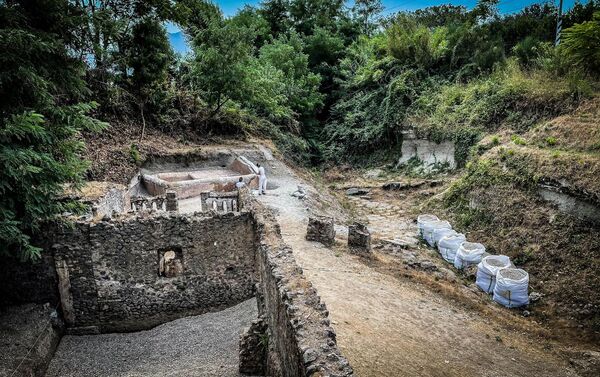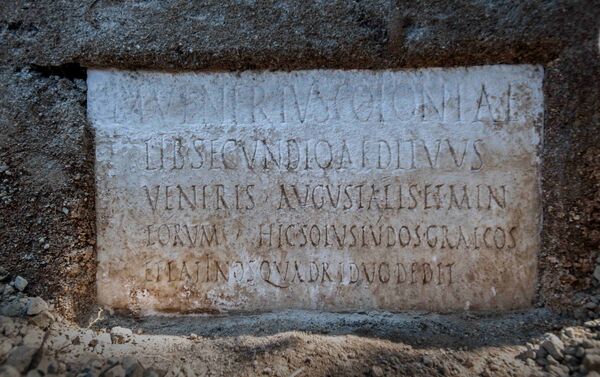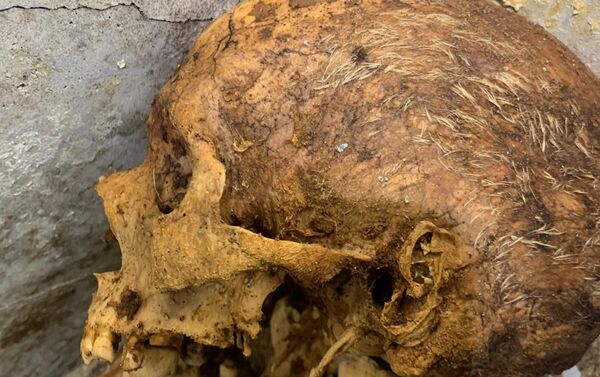Photos: Archeologists in Ancient Pompeii Find Mummified Remains of Slave Turned Imperial Cult Priest
00:47 GMT 18.08.2021 (Updated: 11:24 GMT 24.11.2022)

© REUTERS / Parco Archeologico Pompei
Subscribe
Mummified remains were discovered in a tomb at the necropolis at Porta Sarno, which was one of the ancient city's main entrance gates. The tomb is thought to date from the decades before Pompeii was destroyed by Mount Vesuvius' explosion in 79 AD.
Archeologists of the joint initiative of the European University of Valencia and the Archaeological Park of Pompeii working in the ancient Roman city have discovered the partially mummified remains of a former slave who advanced through the social ranks, reaching the position of imperial cult priest, the park announced.
The remains, which are based on the gravestone, belong to Marcus Venerius Secundio and still contain his white hair and a partially visible ear. They have thus been hailed as the best-preserved human remains yet unearthed in Pompeii. According to preliminary testing, the former slave died around the age of 60.
This discovery is quite rare, according to archeologists, because adult individuals who died during the Roman era were customarily cremated. In the grave, there was also a glass urn with the name of a woman, Novia Amabilis, who could have been Secundio's wife.
Moreover, pieces of cloth were found in the tomb, as well as some funerary utensils. Scientists say they have yet to determine whether the priest's remains were so well preserved due to the special microclimate in the sealed tomb or due to deliberate actions before burial.
"Pompeii never ceases to amaze, and has confirmed her place in a story of redemption, as an international role model, and a place where research and new archaeological excavations are taking place once more, thanks to the many professionals in the field of cultural heritage, who with their work never cease to produce extraordinary results for the world which are a source of pride for Italy," Italian Minister of Culture, Dario Franceschini is quoted in a statement upon the findings as saying.
According to the archeological park, Secundio was a slave who was the custodian of the Temple of Venus in Pompeii. He became a member of the Augustales, a college of priests in charge of emperor worship, after being released from slavery.
And the fact that he was buried in a tomb indicates that he had achieved a high social and economic status.

Archaeologists work at a burial site where a partially mumified skeleton was discovered in this undated photo obtained August, 17, 2021, in Pompeii, Italy. Parco Archeologico Pompei/Handout via REUTERS ATTENTION EDITORS - THIS IMAGE HAS BEEN SUPPLIED BY A THIRD PARTY. NO RESALES. NO ARCHIVES

2/6
© Photo : Archaeological Park of Pompeii/University of Valencia
An inscription on the tomb of Secundio, which tells about his life

3/6
© Photo : CESARE ABBATE
A tomb with human remains and furnishings was found in the necropolis of Porta Sarno, east of the ancient urban center of Pompeii. On the marble slab placed on the pediment of the tomb a commemorative inscription of the owner Marcus Venerius Secundio extraordinarily recalls the performance in Pompeii of shows in Greek, never before directly attested. This is the latest discovery of Pompeii, which took place during an excavation campaign promoted in the area of the necropolis of Porta Sarno, by the Archaeological Park of Pompeii and by the European University of Valencia Naples 16 August 2021. ANSA / CESARE ABBATE

4/6
© Photo : Archaeological Park of Pompeii/University of Valencia
A closeup photo of the skull of human remains found in a tomb in the ancient Roman city of Pompeii

5/6
© Photo : Archaeological Park of Pompeii/University of Valencia
Mummified remains of Secundio at the discovery site in a tomb in the ancient Roman city of Pompeii

6/6
© Photo : Archaeological Park of Pompeii/University of Valencia
Mummified remains of the former slave Secundio at the discovery site in a tomb in the ancient Roman city of Pompeii, where there laid for almost 2,000 years.
Archaeologists work at a burial site where a partially mumified skeleton was discovered in this undated photo obtained August, 17, 2021, in Pompeii, Italy. Parco Archeologico Pompei/Handout via REUTERS ATTENTION EDITORS - THIS IMAGE HAS BEEN SUPPLIED BY A THIRD PARTY. NO RESALES. NO ARCHIVES
2/6
© Photo : Archaeological Park of Pompeii/University of Valencia
An inscription on the tomb of Secundio, which tells about his life
3/6
© Photo : CESARE ABBATE
A tomb with human remains and furnishings was found in the necropolis of Porta Sarno, east of the ancient urban center of Pompeii. On the marble slab placed on the pediment of the tomb a commemorative inscription of the owner Marcus Venerius Secundio extraordinarily recalls the performance in Pompeii of shows in Greek, never before directly attested. This is the latest discovery of Pompeii, which took place during an excavation campaign promoted in the area of the necropolis of Porta Sarno, by the Archaeological Park of Pompeii and by the European University of Valencia Naples 16 August 2021. ANSA / CESARE ABBATE
4/6
© Photo : Archaeological Park of Pompeii/University of Valencia
A closeup photo of the skull of human remains found in a tomb in the ancient Roman city of Pompeii
5/6
© Photo : Archaeological Park of Pompeii/University of Valencia
Mummified remains of Secundio at the discovery site in a tomb in the ancient Roman city of Pompeii
6/6
© Photo : Archaeological Park of Pompeii/University of Valencia
Mummified remains of the former slave Secundio at the discovery site in a tomb in the ancient Roman city of Pompeii, where there laid for almost 2,000 years.
"Here we have another tessera of a large mosaic, namely the multi-ethnic Pompeii of the early Imperial Age, where Greek, the then lingua franca of the eastern Mediterranean, is indicated alongside Latin," he added.
In recent years, dozens of fresh finds have been made at Regio V, a vast portion of the archaeological site that has yet to be fully opened to the public, including the remains of people and animals killed by the Mount Vesuvius eruption.



